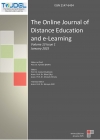TOJDEL - Volume 1 - Issue 4 - October 2013
 Comparison of Computer Assisted Language Learning Software before Investment
Comparison of Computer Assisted Language Learning Software before Investment Dinçer Biçer, Ramazan ükrü Parmaksız
Abstract: Decreasing cost and increasing multimedia functions have made computers popular tool in education in the last decade. CALL refers to the Computer-Assisted Language Learning. Using CALL, students can individualize their studies and study at the pace they desire (Raschio, 1990). Also, advanced tracing and recording capability of CALL permit instructors to monitor their students’ progress (Bland et al. 1990). However, availability of such features shows differences among CALLs. Not many comparative studies have been conducted to compare the CALL Software. The purpose of this study is to compare the features of two Computer-Assisted Language Learning software using qualitative research methodology. Students and instructors having experience in using CALL software at the Foreign Languages Compulsory Preparatory Program of a university participated in the study. Categories are used for the comparison based on the content analysis of data. Recommendations are made to the administrators of education institutions considering making such investment..
 Comparison of Quality of Service of Distance Education at Universities
Comparison of Quality of Service of Distance Education at Universities Tolga Dursun, Kader Oskaybaş, Cansu Gökmen
Abstract: The difference between the distance education and the formal education system is to provide different requirements, expectations and environments the provision of training opportunities to people. In this way, there is a huge population that has an opportunity to get distance education. Increase of service sector firms and gain more profit by providing service to their customers have made the concept of quality of service more crucial today. This study seeks to compare the service quality between the universities.
 Improving Distance Education System: Problems and Solutions from the Perspective of Lecturers
Improving Distance Education System: Problems and Solutions from the Perspective of Lecturers Sima NART,  Remzi ALTUNISIK
Abstract: The modern Internet-based distance education is steadily moving forward, and has attracted more and more people’s attention and gradually showed strong development momentum. The aim of this study is to assess the existing distance education practices at Sakarya University’s eMBA program in terms of pros and cons as well as evaluate problems encounted by the lecturers. Also, we have discussed the possibility of solutionts to the problems form the lecturers’ perspective. The aim of this study is to assess the existing distance education practices at Sakarya University’s eMBA program in terms of pros and cons as well as evaluate problems encounted by the lecturers. Also, we have discussed the possibility of solutionts to the problems form the lecturers’ perspective.
 Solar Powered Digital Equipments for Distance Learning In Developing Countries
Solar Powered Digital Equipments for Distance Learning In Developing Countries S. M. Lutful Kabir, A. Hasib Chowdhury
Abstract: Digital equipment and devices have become most essential tools for disseminating knowledge in educational institutions. The use of such equipment has now become more effective with the inclusion of contents available in the Internet. All of these tools and means have created a great opportunity for spreading teaching and learning in distance educational mode. But for a developing country, the main hindrances for spreading distance education are the cost of the equipment and availability of Internet access over all parts of the country. A research has been carried out on how the cost of useful digital gadgets and their accessories can be brought down to an affordable price and how the access to the Internet can be made easy for the students in general. This paper starts with the description of the challenges for reaching the objectives and then it explains how they are overcome by different indigenous technical solutions. Moreover, work on how the power requirement for the commonly used digital equipment has been minimized is reported in the paper. Finally it shows the techniques of applying solar power to supply the energy requirement for the gadgets to be used for distance learning. This has made a break through in education sector for a vast community in developing countries.


